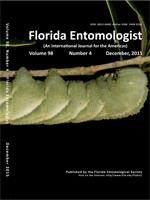There is a growing interest in cultivating olives Olea europaea L. (Lamiales: Oleaceae) in Florida, USA. Although some parts of Florida seem well suited for olive production, the pests and diseases associated with cultivated olives in Florida are generally unknown. During a 2014 survey of olives being grown at the commercial and homeowner level, a novel pest was identified. A hornworm (Fig. 1), now known to be the larval stage of the rustic sphinx Manduca rustica (F.) (Lepidoptera: Sphingidae) (Wagner 2010; D. L. Wagner, personal communication), was reported as a pest of concern by growers from the Florida Panhandle in the north to Polk County in the south. Tuttle (2007) described M. rustica as a broadly distributed Neotropical species that breeds in the mid-Atlantic states as far north as Delaware, USA. In Florida, Heppner (2003) reported M. rustica ranges as far south as Miami-Dade County, but the species has not been reported from Monroe County (the Florida Keys).Worldwide, there are 49 recorded lepidopteran pests of O. europaea, 9 of which are in the family Sphingidae, but none is within the genus Manduca (Robinson et al. 2010). The primary concern of growers was the defoliation caused by larval feeding. One larva can quickly denude a 2-yr-old olive tree, causing problems for nursery producers and for growers with new plantings. Although trees can recover from this damage, olive trees are slow growing, and feeding damage can remain apparent for several months depending on the time of year.
Fig. 1.
The rustic sphinx Manduca rustica found feeding on olive Olea europaea in Suwannee County, Florida. Photograph by Lyle J. Buss.

Manduca rustica is listed as having a host range that includes plants in the family Oleaceae (Kitching & Cadiou 2000; Tuttle 2007; Robinson et al. 2010); however, we were unable to find any report that it has been recorded as feeding on O. europaea. The rustic sphinx moth is recognized as a pollinator in the southeastern United States (Graham 2010). The only notable report of the rustic sphinx as a pest comes from Clavijo & Chacín (1992), who reported M. rustica as a pest of sesame in Venezuela. This is important to note for growers who are interested in using sesame as a cover crop or an attractant for beneficial insects near olive production areas in Florida.
Initial reports from growers included photos of specimens collected from orchards and nurseries. Many growers elected to control mechani- cally (hand pick) the larvae when possible, but some resorted to using insecticide applications. It is interesting to note that one grower reported finding several larvae with white bumps. We collected a specimen and were able to identify the bumps as cocoons of Cotesia congregata (Say) (Hymenoptera: Braconidae) (Fig. 2). This initial collection of a parasitized larva was from Alachua County, Florida. To date, this is the first finding of C. congregata from M. rustica. However, a photograph of a larva with cocoons and exit wounds was submitted from a commercial olive producer in Suwannee County, Florida. As more olive groves are planted in Florida, we anticipate that more feeding damage will be caused by M. rustica. It remains to be determined if C. congregata will provide some level of control of M. rustica for Florida olive growers.
Fig. 2.
A parasitized rustic sphinx Manduca rustica found on olive Olea europaea in Alachua County, Florida. Protruding larva (indicated by the red arrow), cocoons, and an adult Cotesia congregata can be seen in the photograph. Photograph by Lyle J. Buss.

All photographs were taken by Lyle J. Buss. We acknowledge identification assistance from David Wagner (M. rustica), University of Connecticut, and Christopher Crockett (C. congregata), University of Florida. We would like to thank the president of the Florida Olive Council, Michael Garcia, for assistance locating producers and samples. We also would like to thank the following Florida producers for supplying samples and information on olive pests: Kent Cannon, Alachua County; Richard Williams and family, Florida Olive Systems, Volusia County; Rik Davis, Certified Crop Consultant, Volusia County; and Jonathan Carter, Florida Olive Farms, Suwannee County.
Summary
The rustic sphinx Manduca rustica (F.) (Lepidoptera: Sphingidae) has been identified as an occasional pest for olive Olea europaea L. (Lamiales: Oleaceae) in Florida, USA. Reports of this pest's distribution on olive trees in Florida range from the northern Panhandle as far south as Polk County.
Key Words: rustic sphinx; feeding damage; Cotesia congregate
Sumario
El esfingido rústico Manduca rustica (F.) (Lepidoptera: Sphingidae) ha sido identificado como una plaga ocasional del olivo, Olea europaea L. (Lamiales: Oleaceae), en la Florida, EE.UU Los informes de la distribución de esta plaga en los árboles de olivo en la Florida son desde el norte de Panhandle hasta el sur del condado de Polk.
Palabras Clave: esfinge rústico; daño por alimentación; Cotesia congregate





